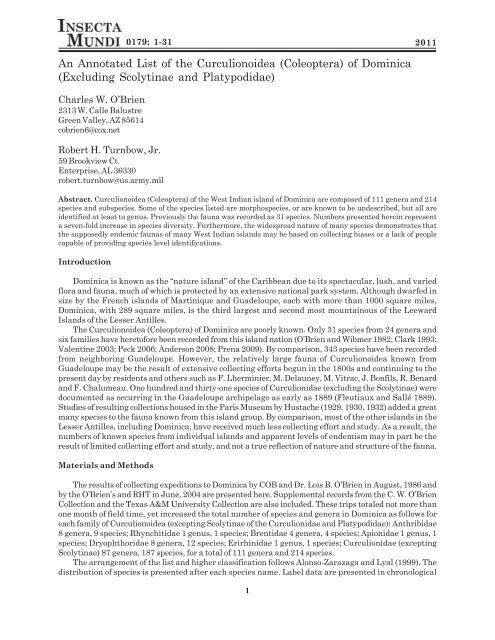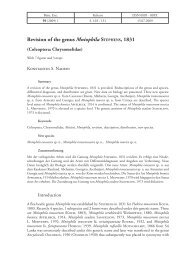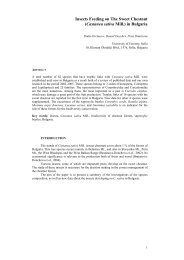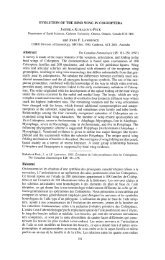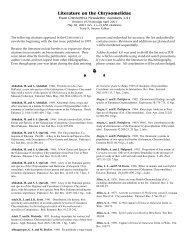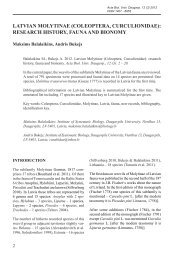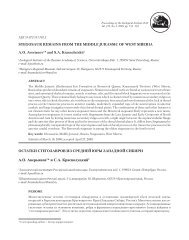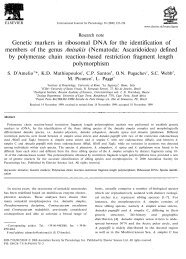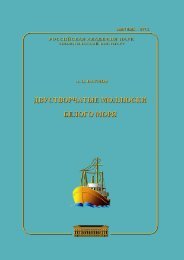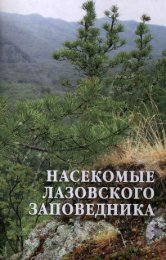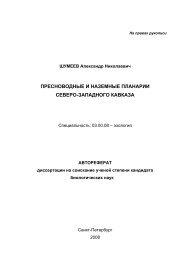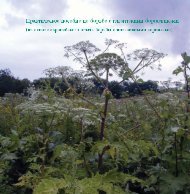INSECTA - Center for Systematic Entomology
INSECTA - Center for Systematic Entomology
INSECTA - Center for Systematic Entomology
Create successful ePaper yourself
Turn your PDF publications into a flip-book with our unique Google optimized e-Paper software.
0179: 1-31 2011<br />
An Annotated List of the Curculionoidea (Coleoptera) of Dominica<br />
(Excluding Scolytinae and Platypodidae)<br />
Charles W. O’Brien<br />
2313 W. Calle Balustre<br />
Green Valley, AZ 85614<br />
cobrien6@cox.net<br />
Robert H. Turnbow, Jr.<br />
59 Brookview Ct.<br />
Enterprise, AL 36330<br />
robert.turnbow@us.army.mil<br />
Abstract. Curculionoidea (Coleoptera) of the West Indian island of Dominica are composed of 111 genera and 214<br />
species and subspecies. Some of the species listed are morphospecies, or are known to be undescribed, but all are<br />
identified at least to genus. Previously the fauna was recorded as 31 species. Numbers presented herein represent<br />
a seven-fold increase in species diversity. Furthermore, the widespread nature of many species demonstrates that<br />
the supposedly endemic faunas of many West Indian islands may be based on collecting biases or a lack of people<br />
capable of providing species level identifications.<br />
Introduction<br />
Dominica is known as the “nature island” of the Caribbean due to its spectacular, lush, and varied<br />
flora and fauna, much of which is protected by an extensive national park system. Although dwarfed in<br />
size by the French islands of Martinique and Guadeloupe, each with more than 1000 square miles,<br />
Dominica, with 289 square miles, is the third largest and second most mountainous of the Leeward<br />
Islands of the Lesser Antilles.<br />
The Curculionoidea (Coleoptera) of Dominica are poorly known. Only 31 species from 24 genera and<br />
six families have hereto<strong>for</strong>e been recorded from this island nation (O’Brien and Wibmer 1982; Clark 1993;<br />
Valentine 2003; Peck 2006; Anderson 2008; Prena 2009). By comparison, 343 species have been recorded<br />
from neighboring Guadeloupe. However, the relatively large fauna of Curculionoidea known from<br />
Guadeloupe may be the result of extensive collecting ef<strong>for</strong>ts begun in the 1800s and continuing to the<br />
present day by residents and others such as F. Lherminier, M. Delauney, M. Vitrac, J. Bonfils, R. Benard<br />
and F. Chalumeau. One hundred and thirty-one species of Curculionidae (excluding the Scolytinae) were<br />
documented as occurring in the Guadeloupe archipelago as early as 1889 (Fleutiaux and Sallé 1889).<br />
Studies of resulting collections housed in the Paris Museum by Hustache (1929, 1930, 1932) added a great<br />
many species to the fauna known from this island group. By comparison, most of the other islands in the<br />
Lesser Antilles, including Dominica, have received much less collecting ef<strong>for</strong>t and study. As a result, the<br />
numbers of known species from individual islands and apparent levels of endemism may in part be the<br />
result of limited collecting ef<strong>for</strong>t and study, and not a true reflection of nature and structure of the fauna.<br />
Materials and Methods<br />
The results of collecting expeditions to Dominica by COB and Dr. Lois B. O’Brien in August, 1986 and<br />
by the O’Brien’s and RHT in June, 2004 are presented here. Supplemental records from the C. W. O’Brien<br />
Collection and the Texas A&M University Collection are also included. These trips totaled not more than<br />
one month of field time, yet increased the total number of species and genera in Dominica as follows <strong>for</strong><br />
each family of Curculionoidea (excepting Scolytinae of the Curculionidae and Platypodidae): Anthribidae<br />
8 genera, 9 species; Rhynchitidae 1 genus, 1 species; Brentidae 4 genera, 4 species; Apionidae 1 genus, 1<br />
species; Dryophthoridae 8 genera, 12 species; Erirhinidae 1 genus, 1 species; Curculionidae (excepting<br />
Scolytinae) 87 genera, 187 species, <strong>for</strong> a total of 111 genera and 214 species.<br />
The arrangement of the list and higher classification follows Alonso-Zarazaga and Lyal (1999). The<br />
distribution of species is presented after each species name. Label data are presented in chronological<br />
1


